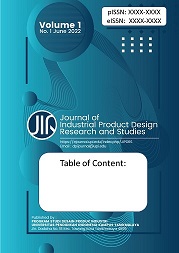Open-Ended Toys to Stimulate Cognitive Development Children Aged 1-3 Years Old in the Pandemic Era
Abstract
Cognitive development is one of the important aspects related to the stages of a child's ability to acquire interpretation and knowledge based on experience and information obtained. One of ways to stimulate children's cognitive development is through the use of open-ended toys. Open-ended toys are a type of toys that provides space for interpretation and can be used in various ways, thereby triggering children's creativity. The purpose of this research was to analyze the use of open-ended toys in stimulating the cognitive development of children aged 1-3 years old in the pandemic era. The method used in this study is qualitative, namely a descriptive analysis of the function aspect of three kinds open-ended toys. Data obtained through literature study, observation, interviews, and documentation. In this research, theory about the stages of children's play development according to Piaget was used. Based on the results of the analysis, it can be seen open-ended toys in the form of puzzles, building blocks, and animal figurines can stimulate children's cognitive development by increasing children's concentration range, language skills, fine motor skills, and gross motor skills in children aged 1-3 years old in the era of the covid-19 pandemic.
Keywords
Full Text:
PDFReferences
Aral, N., Gürsoy, F., and Can-Yaşar, M. (2012). An investigation of the effect of puzzles on preschoolers’ developmental areas. Social and Natural Sciences Journal, 4, 20-23.
Haryani, M., and Qalbi, Z. (2021). Pemahaman guru PAUD tentang alat permainan edukatif (APE) di TK Pertiwi 1 Kota Bengkulu. Jurnal Educhild (Pendidikan & Sosial), 10(1), 6-11.
Hastuti, I., and Santia, A. (2018). Pengaruh permainan building block terhadap kecerdasan visual anak di TK Ulil Albab Kota Bandung. Jurnal Obsesi: Jurnal Pendidikan Anak Usia Dini, 2(1), 70-75.
Kartini, and Susilawati, I. (2018). Pengaruh media pembelajaran lego untuk meningkatkan kreatifitas anak usia dini. Dunia Anak: Jurnal Pendidikan Anak Usia Dini, 1(2), 3-43.
Liao, S. Y. (2012). The application of piaget and bruner’s cognitive-developmental theory in children's dance teaching. The International Journal of Arts Education, 10(2), 164-197.
Pahlevy, T., and Mardiana, C. (2021). Pengembangan desain mainan kayu edukasi untuk anak prasekolah bertemakan fauna endemik Kalimantan Selatan. Jurnal Desain UNINDRA, 9(1), 92-103.
Purwanto. (2019). Bermain dan berkreasi untuk melatih perkembangan anak usia dini menggunakan puzzle edukatif dari bahan bambu. Jurnal Strategi Desain & Inovasi Sosial, 2(1), 28-41.
Rantina, M., Hasmalena, and Nengsih, Y. K. (2021). Stimulasi aspek perkembangan anak usia 0-6 tahun selama pandemi covid-19. Jurnal Obsesi: Jurnal Pendidikan Anak Usia Dini, 5(2), 1578-1584.
Virianingsih, P. P., Tegeh, I. M., and Ujianti, P. R. (2021). Alat permainan edukatif maze dua sisi (MADASI) untuk menstimulasi keterampilan sensori motorik anak. Jurnal Pendidikan Anak Usia Dini Undiksha, 9(1), 117-126.
DOI: https://doi.org/10.17509/jipdrs.v1i2.46620
Refbacks
- There are currently no refbacks.
Copyright (c) 2023 Nurul Fitriana Bahri, Alvian Fajar Setiawan

This work is licensed under a Creative Commons Attribution-ShareAlike 4.0 International License.

This work is licensed under a Creative Commons Attribution-ShareAlike 4.0 International License.


